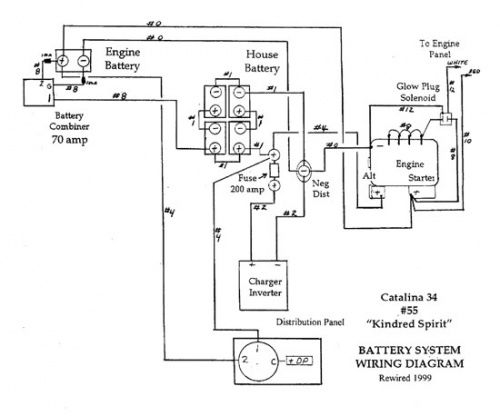Wiring Diagram with Four 6V Golf Cart Batteries & Separate Starting Battery
(Redirected from Electrical/12V system upgrade-CaptAl)
Jump to navigation
Jump to search
Capt. Al, Kindred Spirit #55
Steps taken:
- Disconnect alternator wire from starter sol and bring up to common on battery switch with house feed.
- Disconnect starter power wire from back of battery switch (was with house feed) and place on #2 side of switch so it is directly to the #2 starter battery. Could add disconnect further down the line.
- The #1 on battery switch still goes to the #1 house bank batteries. Connect Freedom 10 directly to house bank batteries.
- Connect West Marine Combiner between the #1 house bank batteries and the #2 starter battery.
Notes:
- It is a SeaFuse holder from West Marine ($19.89) and a Mega fuse 200 amp with holes on two inch center to fit the stud connectors on the fuse holder.
- The “DP” is the Distribution Panel that has all the 12v boat items that draw all that power.
- With the four 6 volt golf cart batteries you don't add the amps when you combined them to get 12v but you do add them when you connect the two pairs together at 12 volt each set, so if each 6 volt golf cart battery is 220 amp hrs, you get a total amp hour supply of 440 amp hrs. Plus, if I need more I can add the engine battery. (I used Dunlop GC-2, 6v, 220 amp hour batteries.)
- I still have the original 1986, 55 amp alternator on the engine. It has an internal regulator and still does a fine job, but if I run the batteries down, it will take a LOT of engine running to fully charge them. I do not worry about it a lot, because I keep the boat plugged in at the dock while I work during the week "to afford it." We motor one half hour to get to good sailing areas so that is a good start and we plug in at the dock over the week. If I ever run the battery bank real low it will take a long time with that alternator. With the Freedom 10 Inverter as a charger, I have fully charged batteries by sailing time.
